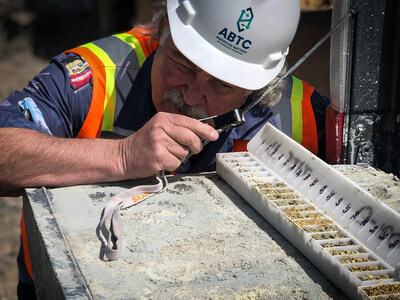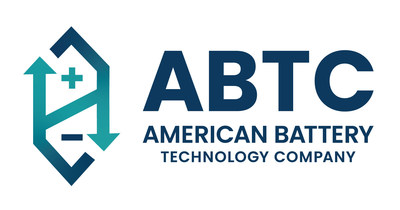One of the Largest Known Lithium Deposits in US Identified at American Battery Technology Company Tonopah Flats Property - Inferred Resource Estimated through S-K 1300 Compliant Study
American Battery Technology Company (ABML) announced an inferred resource of 15.8 million tons of lithium carbonate equivalent at its Tonopah Flats Lithium Project in Nevada, identified as one of the largest lithium deposits in the U.S. The company controls 100% of the mining claims across 10,340 acres. The resource estimate supports a processing rate of 200,000 tons of claystone per day, and leaching trials showed over 90% lithium extraction efficiency. ABML aims to advance the project with a Preliminary Economic Assessment and further drilling to expand resources. The findings are validated by third-party audits under SEC Regulation S-K 1300.
- Inferred resource of 15.8 million tons of lithium carbonate equivalent identified, among the largest in the U.S.
- 100% ownership of mining claims with no royalties, enhancing financial positioning.
- Processing rate supported for 200,000 tons of claystone per day.
- Leaching trials indicate over 90% lithium extraction efficiency.
- Potential exists to expand resources with further drilling.
- Recognition and funding from the U.S. Department of Energy for R&D efforts and a commercial scale project.
- Resource is classified as inferred, which has the lowest level of geological confidence, limiting immediate economic viability.
- Dependency on external funding and permits for project advancement could create delays or uncertainties.
Insights
Analyzing...
Third-party audited analysis estimates inferred resource of 15.8 million tons of lithium carbonate equivalent
In order to perform an unbiased analysis of this data, the mineral resource estimates presented in the ABTC Tonopah Flats Inferred Resource Report were performed by third-party qualified person (QP)
"Having identified one of the largest premier lithium deposits in the
Melsert continued, "The development of a resource needs to be paired with the development of targeted technologies for the extraction of these metals, and we are proud to have spent the past several years developing technologies specifically targeted at these
Report Highlights
- The ABTC Tonopah Flats inferred resource is one of the largest known lithium deposits in the
U.S. with an estimated 15.8 million tons of lithium carbonate equivalent - The large-tonnage nature of the deposit, combined with the company's internally-developed lithium extraction and hydroxide manufacturing techniques validated and supported through numerous government awards, makes it a potentially critical source of domestically produced lithium to meet increasing demand for lithium products
- There is potential to significantly expand the resources with further drilling extending to the north and south property boundaries and at greater depths
- Leaching trials were carried out in-house by ABTC using statistically representative homogenized bulk samples, and these trials demonstrated that over
90% of lithium can be extracted from the Tonopah Flats property claystone within a few hours - The project is ideally situated close to infrastructure and the town of
Tonopah , making it attractive for future development - Resource estimates were calculated based on a pit-constraint, conservative cutoff concentration of 300 ppm Li that support a 200,000 ton per day claystone process rate
- Click here for a 3D interactive walkthrough of ABTC's Tonopah Flats Inferred Resources: https://vrify.com/decks/12566-tonopahflats
Tonopah Flats Mineral Resource Estimate
Classification | Cutoff (ppm Li) | Total Resource | Avg Li | Lithium Tons | Lithium |
Inferred | 300 | 5,289,000 | 561 | 2,970,000 | 15,800,000 |
The mineral resource estimates for the ABTC Resource Report were classified by geological and quantitative confidence in accordance with the SEC Regulation S-K 1300. The mineral resources for Tonopah Flats described and tabulated in this report are entirely classified as Inferred and were estimated to reflect potential open-pit extraction.
The lithium resources at Tonopah Flats were modeled and estimated by:
- Developing a geological model of the deposit
- Evaluating the drill-hole lithium assay data statistically
- Utilizing the geological model as the base for interpreting lithium mineral domains on a set of cross sections spaced at 500-foot intervals
- Projecting the sectional mineral-domain polygons horizontally to the drill data within each sectional window, thereby creating three-dimensional polygons
- Using the polygons to create three-dimensional wireframe solids of the mineral domains
- Coding a block model comprised of 100 x 100 x 20 (x, y, z) -foot blocks to the mineral domains using the wireframe mineral-domain solids
- Analyzing the modeled mineralization domains statistically to aid in the establishment of estimation and classification parameters
- Interpolating lithium grades by inverse-distance to the third power into the block model using the coded lithium-domain percentages to explicitly constrain the grade estimations
- Constraining the resource with a pit optimization to determine a shape and cutoff grade satisfactory to meet the requirement of reasonable prospects for eventual economic extraction
Status of Exploration, Development, and Operations
Exploration conducted by ABTC commenced in the Summer of 2021 and has included both surface sampling and drilling. ABTC collected 29 surface samples in
Metallurgical Testing and Mineral Processing
The Tonopah Flats deposit is comprised of lithium-rich sedimentary claystone with negligible work index and abrasion, and readily disaggregates when suspended in water. Standard assaying of head grades was performed using a representative array of samples selected from 21 drill holes. For metallurgical leaching trials, bulk samples from the Tonopah Flats project were prepared for lithium leach trials using roughly 700 pounds of cuttings from the 2021-2022 drill hole program. These metallurgical leaching trial samples were collected from drill hole TF-2208, where the average head-grade for lithium was found to be about 790 ppm. The sample was homogenized by cone-and-quarter methods and pulverized to 100 mesh to obtain a statistically repetitive sample. Mineral processing was carried out at the
Leaching trials were carried out in-house by ABTC using statistically representative homogenized bulk samples, and these trials demonstrated that over
To further validate and optimize these metallurgical and mineral processing techniques, ABTC summarized the results of its bench scale trials for the manufacturing of battery grade lithium hydroxide specifically from these
Due to the positive results from these bench scale validations, the ABTC team applied for a second round of
"We are extremely pleased with the results of our Resource Report for our
Next Steps
With the data generated in this report, ABTC intends to take the following steps to further advance this project.
- Perform a Preliminary Economic Assessment (PEA) to analyze the potential viability of this resource and the related commercial scale lithium hydroxide facility
- Perform additional infill and extension drilling to further expand the mineral resource to the North, South, and at depth and to advance the resource from Inferred to Measured and Indicated
- Publish an updated mineral resource report based on the additional drill data and continued metallurgical test work
- Evaluate the performance of the field pilot plant that is being constructed as part of the current
U.S. DOE Advanced Manufacturing Office grant in order to further detail the economic viability of the lithium hydroxide refinery - Perform a Pre-Feasibility Study (PFS) to quantify the impacts of developing this resource and constructing the commercial scale lithium hydroxide refinery
For more information on
Qualified Person
The mineral resource estimates presented in the ABTC Tonopah Flats Resource Report were performed by third-party QP RESPEC, LLC and were classified by geological and quantitative confidence in accordance with the
Inferred Resource
Inferred mineral resource is that part of a mineral resource for which quantity and grade or quality are estimated on the basis of limited geological evidence and sampling. The level of geological uncertainty associated with an inferred mineral resource is too high to apply relevant technical and economic factors likely to influence the prospects of economic extraction in a manner useful for evaluation of economic viability. Because an inferred mineral resource has the lowest level of geological confidence of all mineral resources, which prevents the application of the modifying factors in a manner useful for evaluation of economic viability, an inferred mineral resource may not be considered when assessing the economic viability of a mining project, and may not be converted to a mineral reserve.
About
Forward-Looking Statements
This press release contains "forward-looking statements" within the meaning of the safe harbor provisions of the
![]() View original content to download multimedia:https://www.prnewswire.com/news-releases/one-of-the-largest-known-lithium-deposits-in-us-identified-at-american-battery-technology-company-tonopah-flats-property--inferred-resource-estimated-through-s-k-1300-compliant-study-301758014.html
View original content to download multimedia:https://www.prnewswire.com/news-releases/one-of-the-largest-known-lithium-deposits-in-us-identified-at-american-battery-technology-company-tonopah-flats-property--inferred-resource-estimated-through-s-k-1300-compliant-study-301758014.html
SOURCE









